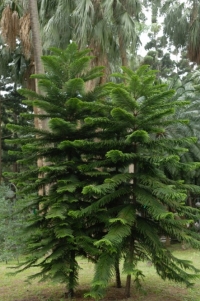TELDAP Collections
| Gymnosperms Garden |
|
Gymnosperms are perennial plants; they mostly grow in temperate zone in large forests. They have evolved since the Paleozoic Era (about three hundred million years ago). The first obvious characteristic is the naked seed on the scales of a cone or cone-like structure without developing into a fruit (not enclosed by a ripened ovary). It includes conifer family (pines - Pinaceae, Chinese fir trees - Taxodiaceae, cypress trees - Cupressaceae) and cycad tree (Cycadaceae) etc. There are 250 thousand species of vascular plants world wide with more than 600 species of gymnosperms, and some of them are disappearing. The flower of gymnosperms does not have vivid pretty colours, nor petals or calyx; it is aggregated of multiple unisexual flowers which called strobilus. They pollinate by means of wind. Beside Pines (Pinaceae), Chinese fir trees (Taxodiaceae) and part of cypress trees (Cupressaceae), the seeds of Araucariaceae and megasporophyll aggregation in cones, otherwise, the seed of the rest family is in drupe. Most of gymnosperms are well used in ornamental, horticulture, building constructs, carved sculptures, ingredients of papermaking...etc which world wide used. There are 35 species in this Garden including Cycas taitungensis, Amentotaxus formosana, Keteleeria davidiana, Podocarpus costalis etc. They have been selected into rare plant conservation for protection and plan into nature reserve areas. Dawn redwood (Metasequoia glyptostroboides) native to mainland China which had assigned the name Taxites based on fossil records. Taiwania cryptomerioides Hayata’s Latin name – Taiwania was named after Taiwan which is epoch-making.
Taipei Botanical Garden (TPBG) , Taiwan Forestry Research Institute.
|













